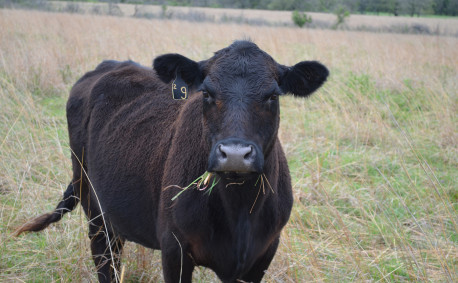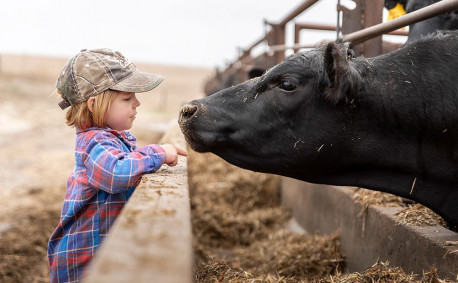Antibiotics and Vaccines in Livestock
Caring for cattle—it’s a concept that may sound strange to some. How can people say they care for an animal that will end up on the dinner table? For ranchers, taking proper care of their cattle is about animal welfare and a good business practice.
In fact, the two go hand in hand. Animals that are well cared for experience less stress, which results in a higher quality meat.
 “We provide for our cattle because they provide for us,” says Amy Perrier of Dalebanks Angus in Eureka.
“We provide for our cattle because they provide for us,” says Amy Perrier of Dalebanks Angus in Eureka.
“We care and we want to do the right things in animal production,” adds her husband Matt. “The cattle come first.”
We got a firsthand look at how Dalebanks cares for its animals during a Day at the Ranch.
Some people paint a scary picture of animals being pumped full of antibiotics or vaccinated out the wazoo. But the reality is far from this. In every aspect from breeding to raising cattle, ranchers take extreme care.
We’ll look at two common misperceptions in caring for cattle: antibiotics and vaccines.
Antibiotic Use in Meat Production
Think of your own family. If one of your kids is sick, you want them to get better. Sometimes that requires medical care, and certain conditions require certain treatments. A doctor won’t prescribe your child antibiotics if she doesn’t need it. The same is true for ranchers and veterinarians.
Cattle are given antibiotics only when absolutely necessary, and only in proper doses with veterinary oversight.
 “We use them judiciously,” Matt says. “We use them only when we have to.”
“We use them judiciously,” Matt says. “We use them only when we have to.”
Once antibiotics are administered, a strict waiting or “withdrawal” period is required before that animal can be processed into meat. This is strictly adhered to by ranchers to make sure the cattle are healthy and the beef we eat is safe.
As with beef, milk production is heavily monitored. If any amount of antibiotic is detected in a shipment of milk, the entire tanker trailer will be discarded.
Still, some people think the idea of antibiotic-free cattle sounds good. But the reality is that operations that don’t treat their animals have a greater mortality rate. In other words, more cattle die when not properly treated for infections.
Vaccination Use in Meat Production
In addition to giving sick cattle antibiotics, ranchers make sure their cattle are properly vaccinated.
The vaccines cattle get are similar to those my dogs get either at the vet or with a monthly pill I give at home—Leptospirosis prevention, deworming, and bug repellant. Just like with my dogs, dosage is determined by the animals weight to ensure they are getting just the right amount of protection.
Cattle identifiers like ear tags, brands or tattoos help ranchers keep track of scheduling. With information like weight, dates and doses, strict documentation lets them know which animals have been vaccinated and when they are due for boosters.
This helps ensure compliance and is another element of veterinary oversight.
Administering Medication
Much thought is given to how to administer medications. Modern equipment enables ranchers to administer recommended vaccinations with minimal stress on the animals.
“We try to do as many things as we can to limit stress on these cattle,” Matt says.
 From special equipment to wrangling techniques, every touchpoint is intended to keep the cattle calm.
From special equipment to wrangling techniques, every touchpoint is intended to keep the cattle calm.
At Dalebanks they use a cattle squeeze chute, which was originally designed by animal behaviorist Temple Grandin to reduce animal stress. The chute has sides that come in, hugging the cattle. This not only keeps them from moving while medicine is administered, but it also keeps them calm. Similar compression therapy is used to reduce stress with people and dogs.
“We have introduced a lot of science, a lot of technology to help us do our jobs better,” Matt says. “At the same time, there are a lot of tools that are the same our parents and grandparents used.”
One such technique is that of wrangling. Cowboys aren’t just the stuff of Hollywood movies. A cowboy who knows the ropes—literally—will be calm and confident when handling cattle. That sense of calm will translate to the cattle, helping to reduce their stress.
A rancher’s No. 1 job is to care for her animals, and their welfare is of utmost importance. Being good stewards is how ranchers operate and administering antibiotics and vaccinations is just part of that care.




